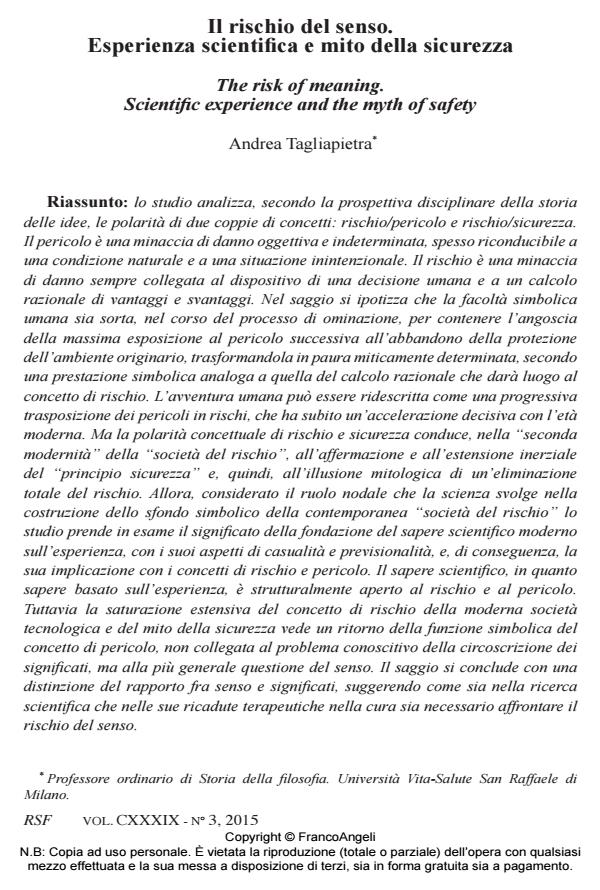The risk of meaning. Scientific experience and the myth of safety
Journal title RIVISTA SPERIMENTALE DI FRENIATRIA
Author/s Andrea Tagliapietra
Publishing Year 2015 Issue 2015/3
Language Italian Pages 20 P. 9-28 File size 2235 KB
DOI 10.3280/RSF2015-003002
DOI is like a bar code for intellectual property: to have more infomation
click here
Below, you can see the article first page
If you want to buy this article in PDF format, you can do it, following the instructions to buy download credits

FrancoAngeli is member of Publishers International Linking Association, Inc (PILA), a not-for-profit association which run the CrossRef service enabling links to and from online scholarly content.
the author analyzes, from the perspective of the history of ideas, the difference between two pairs of related concepts: risk/danger and risk/safety. Danger is the menace of an undetermined yet objective harm which often arises from natural or unintended circumstances. Risk is a threat of injury deriving from a human decision and a rational appraisal of advantages and disadvantages. The author hypothesizes that the human capacity for symbolic thinking appeared, during the historical process of hominization, in order to cope with the angst caused by leaving a known and protected environment. Symbolic thinking turned angst into a mythically molded fear, performing an operation akin to a rational appraisal and putting forth the contemporary notion of risk. The adventure of mankind can be re-described as a progressive transposition of dangers into risks, process that accelerates rapidly during the modern age. In the "second modernity", or "risk society", the polarity between risk and safety generates an ever-expanding "principle of safety", a mythical illusion that risks could be eliminated forever. The author, taking into consideration the key role played by science in the symbolic framing of today’s "risk society", analyses the significance of the founding of modern scientific knowledge based on experience (and thus on the notions of hazard, predictive power, risk and danger). Scientific knowledge based on experience is intrinsically exposed to risk and danger. However, in our modern technological society, the generalization of the concept of risk (and of the related myth of safety) enhances a return of the symbolic function of the notion of danger, not connected to the intellectual endeavor to understand references, but to the more general question of meaning. The author ultimately underlines the difference between references and meaning suggesting that both researcher and clinician should deal with the risk of meaning.
Keywords: Risk, danger, safety, scientific experience, meaning, reference
Andrea Tagliapietra, Il rischio del senso. Esperienza scientifica e mito della sicurezza in "RIVISTA SPERIMENTALE DI FRENIATRIA" 3/2015, pp 9-28, DOI: 10.3280/RSF2015-003002